
By Peter McCullough
Moorooduc might be little more than a locality but for a number of years it boasted two community halls. Strange? Well, read on …
Progress Hall, a.k.a. The Tin Hall.
In June, 1909 the Moorooduc Progress Association was formed with Messrs Falls and Warland as President and Secretary respectively, and at a meeting later in the year Mr. R. Wilkinson proposed the building of a public hall. The local paper reported that, although his speech was “vigorous”, it did not arouse much enthusiasm. The Progress Association meetings were quite social for at the close of this meeting, held at the home of Cr. T. Male, “…the company adjourned to the spacious breakfast room, tastefully decorated with many varieties of good things suitable for the inner man, and amidst good natured jokes the vacuum caused by the good work at the meeting was replenished.” (Mornington Standard, 2 October, 1909.)
The public hall was raised again in 1912 and, although the prevailing view seemed to be that roads should be a priority, it was decided to call a public meeting to canvass the matter of the hall. ‘Position’ was already looming as an issue. With business completed “… dancing was kept up in the large room and conservatory at ‘Annesleigh’ interspersed with songs and supper at twelve, after which dancing continued until three o’clock.” (Ibid. 10 August, 1912.)
In order to resolve the question of location, Mr. Edward Jones and his son, Mr. Charles Jones, agreed to excise a block from their property located on the corner of Mornington-Tyabb and Derril Roads. Just south of the intersection and opposite the Moorooduc Primary School, it seemed an ideal site. With the location settled, the Progress Association moved quickly and their hall, of tin and weatherboard construction, was opened on 7 April, 1915. “Patrons and friends” were invited to attend and participate in a “sale of gifts” fete. (Ibid. 13 February, 1915)

For some time this building was a hive of activity; with the assistance of kerosene lamps for evening functions dances were held frequently, balls and concerts took place, and it was the regular meeting place for community organisations such as the Farmers’ Union and, of course, the Moorooduc Progress Association. The Church of England was quick to make use of the facility: “The Westernport Parochial Council has granted the local Progress Hall the right to be included in the church parish.” (Ibid. 25 November, 1916.) Alice Jones, a former student of the nearby Primary School, became the first postmistress of Moorooduc, conducting her office in the Progress Hall.
The Brick Hall
In spite of the bonhomie which seemed to prevail at meetings of the Moorooduc Progress Association, there was dissension in the ranks. Although the question of location appears to have been the main bone of contention, there is also the suggestion that the rather modest “Tin Hall”, as it was rather disparagingly referred to by the dissenters, was not in keeping with the general affluence of the area.
Accordingly, a group of residents, led by Mr. Wilkinson, formed the Moorooduc Advance League and decided to erect a more superior building half a mile to the south on the corner of Bentons and Derril Roads. No time was lost. There were no objections to an item on the agenda of the Shire Council: “S.E.McColl, hon.sec. Moorooduc Advance League, submitting plans of Moorooduc Public Hall for Council’s approval.” (Ibid. 20 June, 1914) . Two weeks later (2 July, 1914) tenders were called in the Melbourne Herald by Mr. Wilkinson for “…a brick and concrete public hall, Moorooduc.”
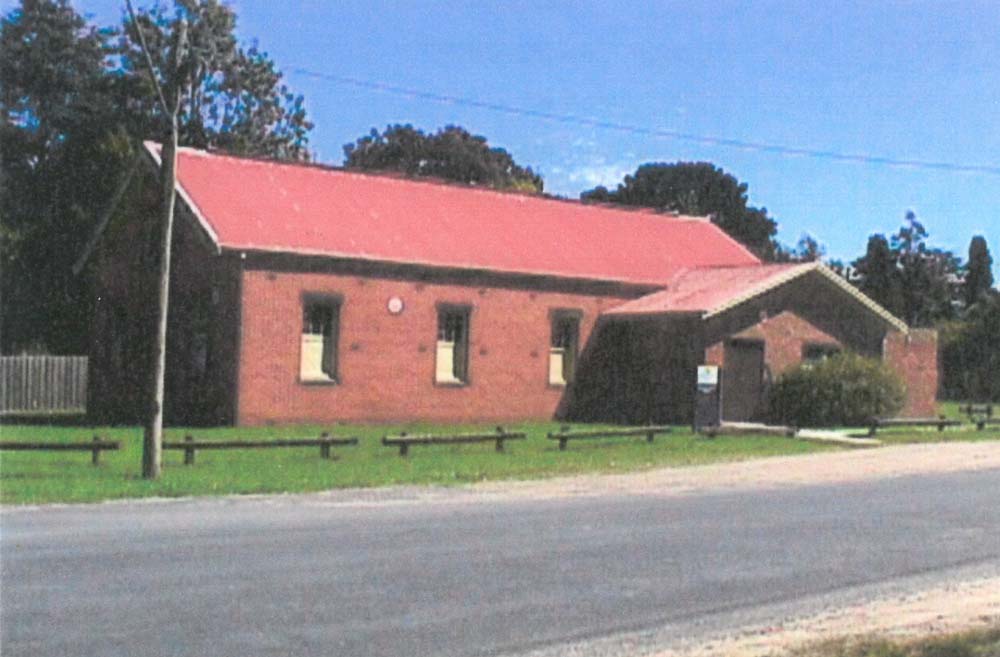
The new public hall, built of Northcote bricks to the design of Mr. Berry of Oakleigh, was opened on 16 June, 1916 by Mr. A. Downward M.L.A. as a crowd in excess of three hundred looked on. Mornington Shire President Flood was in the chair, and the occasion was marked by a concert followed by a dance.
Although the building was less centrally sited than the hall opened fourteen months earlier, it was more modern, and as a result a certain amount of competition and rivalry developed between the Brick Hall and the Tin Hall in a tiny community which might well have found it an effort to support one such building. Even the local primary school, when it was closed for repairs in 1916, held classes in the Brick Hall, some distance down an unmade road, instead of the close-at-hand Tin Hall. A report on the State School Patriotic Concert in 1917 stated that “…the spacious brick hall was taxed to its fullest.” However in 1919 it was reported that the school break-up was held in “the neighbouring hall.” (Ibid. 9 January, 1920.) Interestingly, the speed of its construction notwithstanding, there must have been a few complications: “…a meeting of the Advance League was held in their hall and a lengthy discussion arose on legal points.” (Ibid. 30 September, 1916.)
Occasionally it was hard to work out which hall was being referred to; in 1928 the school committee held a dance in “The Moorooduc Hall” to raise funds for the Shrine of Remembrance (Ibid. 3 August,1928). If the reporter wasn’t sure he resorted to “Moorooduc Hall” and let the readers work it out for themselves!
Faced with the challenge from just along the road the Progress Association did not rest on its laurels: “A working bee on Saturday afternoon was well attended and good work was done in removing the temporary shelter in front of the hall, and getting the foundation in for the additions which the committee have felt in need of. The ladies provided afternoon tea.” (Ibid. 28 October, 1916.) The following year it was reported: “The Progress Association is now putting in pipes to underground drain their land. The anti-room is also being furnished with nice weatherboards.” (Ibid. 11 August, 1917.)
As well as these continued attempts to improve the facilities, social activities at the Tin Hall continued as if nothing had happened. Fortnightly dances continued (Ibid. 4 November, 1916.) and the following year it was reported that “…a fund raising concert had been put on in the Progress Hall by the Mornington Minstrels and Variety Company to raise funds to erect a roll of honour board to the local soldiers.” (Ibid. 1 September, 1917.). A week later a fancy dress ball was held in the Progress Hall (Ibid. 8 September, 1917.) and early in 1918 the Hard Times Ball, held at the same venue, was describes as a “great success.” (Ibid. 4 May, 1918.)
One can only imagine the ill-feeling that existed between the two camps at the time. Local families who were “unaligned” and were holding a family function such as a 21st birthday would seek an alternative venue in Mornington or elsewhere in order to avoid repercussions.
On one occasion the tension was reflected in a letter to the local paper from “Advance Moorooduc” who gloated: “The additions to the tin hall seem to be a failure, while the studs stand there exposed to the weather.” (Ibid. July, 1917.) Perhaps spurred on by this little remark, a working bee which was held “…at the M.P.A. hall and Post Office painted all the most important parts that were feeling the effects of the weather.” This was in preparation for Christmas gatherings and the annual ball. (Ibid. 12 October, 1918.) It was subsequently reported that : “The annual ball of the Moorooduc Progress Association was held on 11 October in the local hall.”(Ibid. 26 October, 1918.) Not the Progress Hall or the Tin Hall, but “the local hall.”
The following year a notice appeared in the local paper advising, at short notice, that the unveiling of the honour board had been “indefinitely postponed.” No reason was given but it is most likely that there was disagreement as to which hall should be the home for this sentimental item. Some years later mention was made of the transfer of this item, for reasons which will soon become obvious, from the Tin Hall to the Brick Hall.
With the competition for support the two rival groups started to feel the pinch. The Moorooduc Progress Association tried to build support but it was reported that their “… circular letter to induce new members did not crowd the hall.” (Ibid. 1 July, 1927.) This was the reporter’s gentle way of saying that the attempt was not not successful. In 1928 a public meeting was held to form a committee of management for the Brick Hall. “The hall is popular for dances, but has been neglected over the past few years, and the debt has increased, an indication of lack of interest in public affairs by local residents… The new committee intends to hold dances which will begin in a fortnight’s time, and a working bee will be held to clean up the accumulated rubbish…” (Ibid. 24 August, 1928.)
With the loss of revenue, and money still owing, the position of the Tin Hall became precarious. But a white knight was at hand.
The Anglicans come to the rescue: the Tin Hall becomes St. Paul’s Church Hall
Soon after the opening of St. Peter’s in Mornington in 1861, Church of England worship commenced in Moorooduc. Initially services were held in a private dwelling, ‘Annesleigh’, and then in the small wooden building in ‘Three Chain Road’ (now the Moorooduc Highway.) which served the early settlers as both church and school.
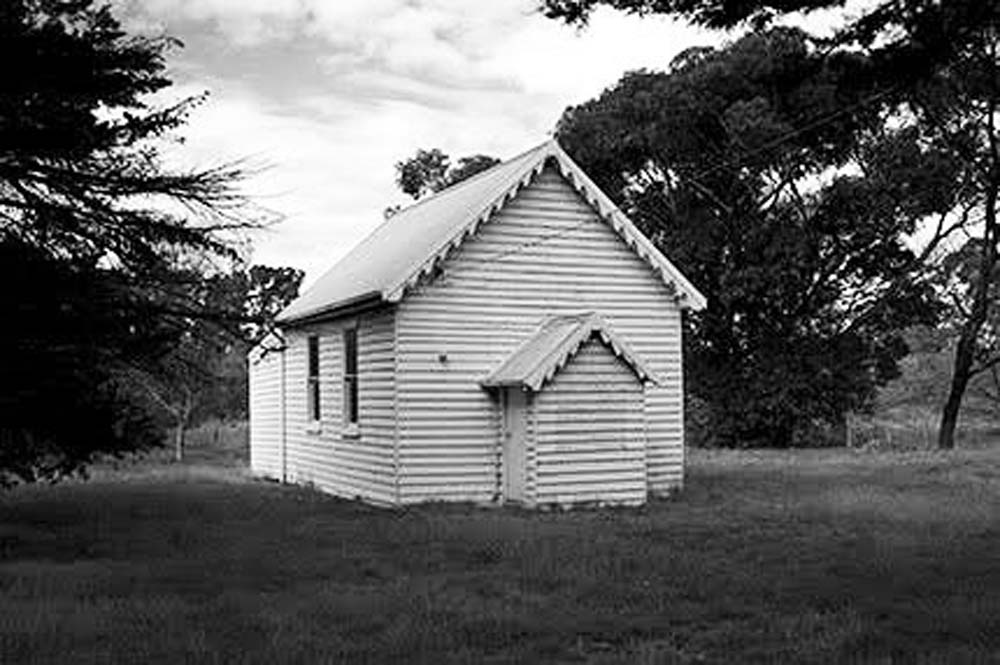
Although services appear to have lapsed for a number of years, the next really positive steps taken by the Anglicans were in 1916 when Moorooduc began a 30 year association with the Parish of Hastings. Worship commenced in the Progress Hall where seven children were christened at a service in January, 1917. (Ibid. 3 February, 1917.)
Enthusiasm increased and in 1920 a block of land (2 acres, 7 perches) was purchased from the Lands Department as the site for a church. The purchase price was 10 pounds, 4 shillings and 5 pence, plus costs of 3 pounds, 6 shillings and 6 pence, and it was located on the east side of Derril Road, slightly north of Bentons Road; it had been part of the Jaen Jaen Military Water Reserve.
By 1927 weekly Sunday School services had started and the attendance at the fortnightly church services had increased to 50. The Tyabb Dramatic Club held a Grand Entertainment at the end of 1929 in the Tin Hall and on another occasion a movie picture “created a good deal of missionary interest.” In 1929 a group of young boys and girls met after school every Thursday afternoon to prepare for a “sale of work”; the Guild had several missionary afternoons of interest to members. The produce from Harvest Festivals was usually conveyed to the Andrew Kerr Memorial Home in Mornington.

While the Tin Hall had become the focal meeting place for the Anglican community, and for which they paid a modest annual rental of one guinea, many members were still keen to establish their own centre of worship. Consideration was given to the clearing of the block purchased in 1920 adjacent to the Recreation Ground, but this did not proceed. Prior to its purchase some difference of opinion existed as to its suitability as a church site, and this was probably a factor in the lack of urgency.
In 1932 the Church’s need for a building, coupled with the plight of those responsible for the Tin Hall, was resolved when the land and hall were purchased by the Church of England for 105 pounds and 5 shillings, plus costs of 6 pounds, 11 shillings and 6 pence. This led to the abandonment of any plans for the building of a church on the southern site and the property was later sold in 1948 for approximately 40 pounds.
Later in 1932 a further 70 pounds and 16 shillings was spent on fitting out the Tin Hall as a church hall, including the building of an altar alcove. A special dedication service was held in March, 1933 in the building which had been “…thoroughly renovated and painted and a chancel added.” It was also noted that these modifications “…can be screened off when the hall is used for other than church services.” (Ibid. 12 March, 1933.) In 1935 further improvements were made to church furnishings.
For some years St. Paul’s Church Hall, as it had now become, was used on alternate Sundays by the Church of Christ and Anglican congregations who frequently attended each other’s services. Quite an emphasis was placed on the missionary aspect. Scouting activities were associated with the church, and there was a regular attendance at services by many of the scouts of the Lone Patrol.
A renewal of church interest was evident in the 1940’s with services each Sunday. An evening service was proposed but the difficulty was a lack of lighting. As the church newsletter reported, a solution was found: “…a social evening was arranged in the Brick Hall by an active band of ladies and the nett result of 10 pounds, 14 shillings, and 6 pence will be sufficient for two Aladdin lamps.” This might sound inadequate but it did not deter a congregation of over 50 from attending the regular evening services.
As has happened in many rural areas, St. Paul’s Church Hall suffered a decline: the Sunday School disappeared and the numbers in the congregation fell away. By 1969 it had ceased to operate.
What next for the Moorooduc Progress Association?
Without the responsibility for the Tin/Progress Hall, the Association took a few years to regroup. During this time the Moorooduc Advance League disbanded. Then in 1944 the Progress Association appeared to experience a revival when they held a dance in the Brick Hall in aid of “the new hall fund” (Ibid. 28 September, 1944). Then it was reported: “The Association has decided to hold a monthly entertainment to build up a fund for the purpose of building a public hall for the district,” (Ibid. 30 November, 1944.)
Surely there wasn’t going to be a third hall in Moorooduc? This possibility was negated when, on the death of the owner, it was decided at a public meeting, held in January 1945 and sponsored by the Progress Association, to purchase the Brick Hall which was still being leased for public entertainment.
The district was canvassed to raise funds so that the Progress Association could make the purchase. This was achieved during 1945 when it was reported that, after paying 300 pounds for the hall, the Association still had a credit balance of 145 pounds. Trustees were empowered to make the necessary arrangements for the erection of a supper room and the installation of electric light. (Ibid. 18 October, 1945.) Flushed with their success, the Moorooduc Progress Association attempted to re-badge the Brick Hall: “…a very successful dance, under the auspices of the Progress Association, was conducted in the Progress Hall…” (Ibid. 31 July, 1947.) To the locals it remained the Brick Hall.
In the years following the purchase of the hall funds were raised by the Progress Association, the Entertainment Committee, and the Gymkhana Society; a new floor was installed, a kitchen and storage shed built, rooms were renovated, and the hall was repainted. Then, after a number of false starts permission for extensions was obtained and a public canvass of the district met with a very generous response. Work commenced in July, 1961 and it was believed that the enlarged building with the addition of stage and dressing rooms would fill a need in the district by providing an entertainment centre for young people. In November, 1961 a gala ball was held to mark the opening of the “…new and splendidly equipped Moorooduc Hall.” (Ibid. 8 November, 1961.)
Moorooduc today
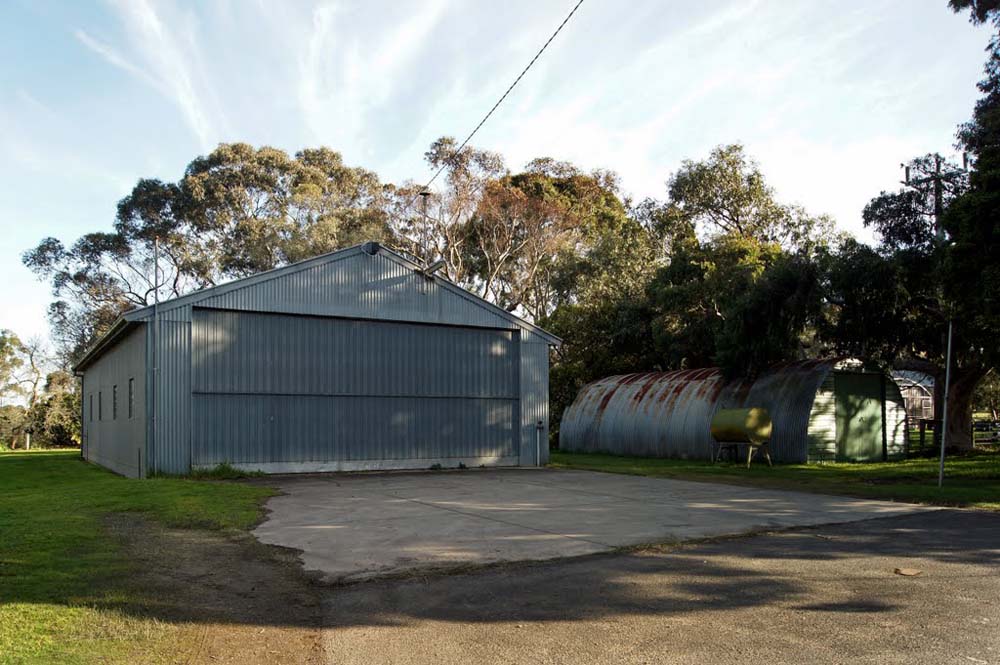
The 1st Moorooduc Scout Troop, which was established in 1952, held their meetings in the Tin Hall until they went into recess in 1968. Then, after the final church service in 1969, the Tin Hall was not used for over 20 years. Although the building itself was somewhat dilapidated, the grounds were kept tidy by members of the Jones family who still owned the adjacent property.
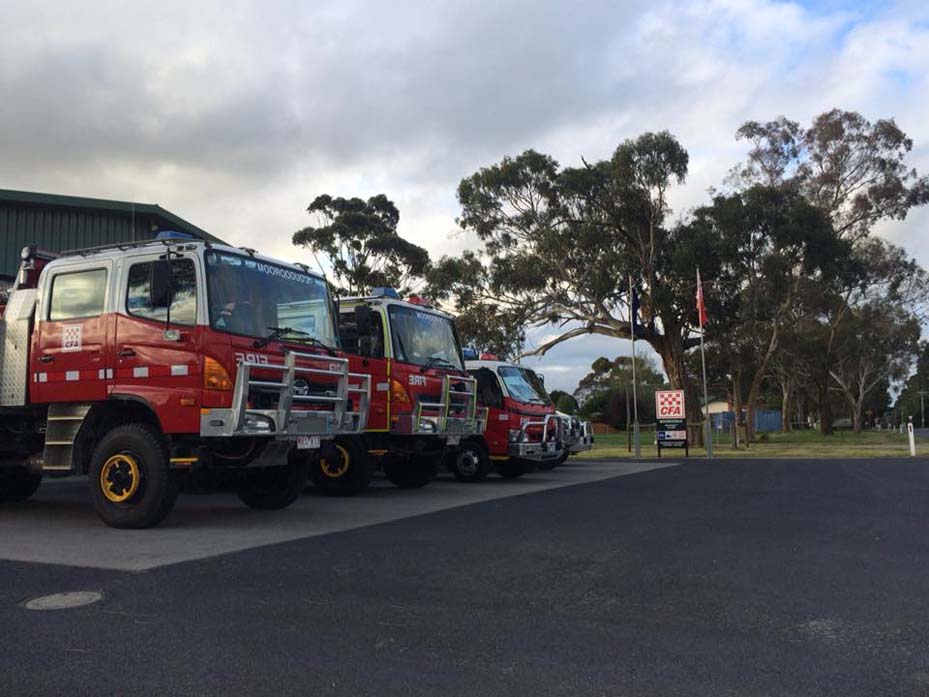
In 1991 the Tin Hall was sold to the Country Fire Authority. It was demolished and an impressive new fire station, large enough to house three vehicles, was constructed. This would seem an appropriate outcome as the Jones family, who originally donated the block to the Progress Association, have been heavily involved in the 70 odd years of the history of the Moorooduc Fire Brigade. Bill and Bette Jones, both now deceased, were instrumental in the establishment of the brigade. They donated the land to house the brigade vehicle in a Nissen hut and converted the first tanker from an ex-army vehicle in the 1950’s. In 1968 a base radio was installed on the Jones’ Derril Road property. Bill was awarded the B.E.M. and the A.F.S.M. (Australian Fire Services Medal) and Bette received the OAM for their contributions to fire fighting in general and the Moorooduc Fire Brigade in particular. Their son, Nev., is the current captain of the brigade and he and other family members were involved in the development and eventual construction of the new station in 1994.

The Brick Hall is sometimes referred to by its official name of “The Moorooduc Hall’, but more commonly it is referred to either as “The Brick Hall’ or even “The Red Brick Hall” The ladies in the C.W.A. take it a step further and, when they are advertising an event, it is held at “The Little Red Brick Hall.” This almost has a fairytale ring to it. Whatever the name, the hall continues to provide outstanding service to the community. The Moorooduc Progress Association still overseas the use and maintenance of the building. It is a regular meeting place for local groups and clubs and is available for hire for social events. For many years it served as the scout hall until the scouts, who had reformed in 1978, obtained their own premises at the rear of the primary school. More recently it has become popular for its regular garage sales and craft expos. In August, 2016 the Brick Hall celebrated its centenary with a very successful open day for past and present residents of Moorooduc.
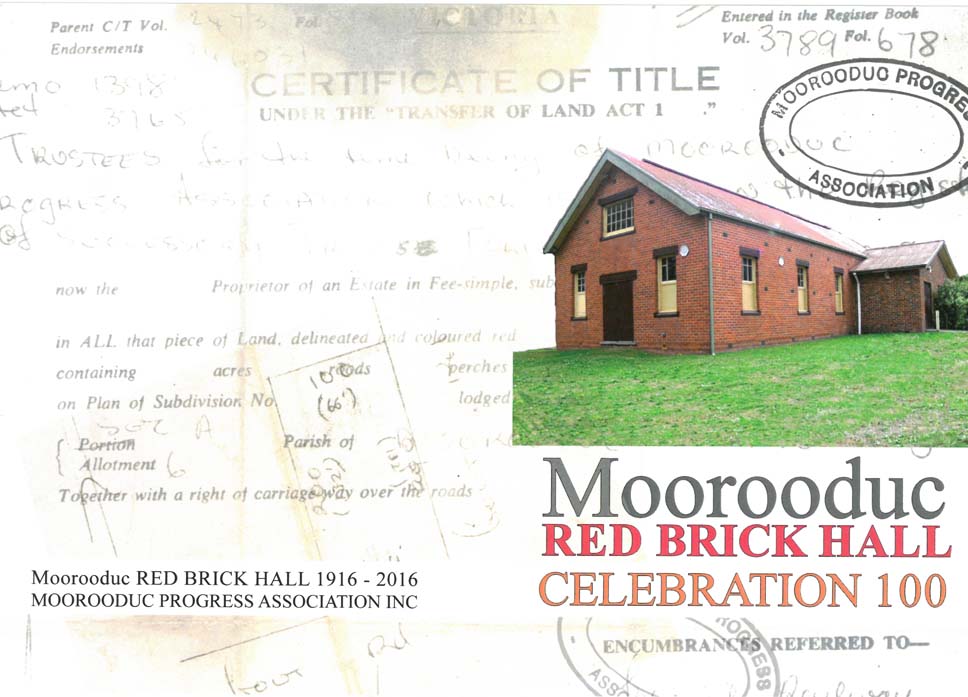
Acknowledgement:
It would be remiss of me not to acknowledge the assistance provided by Valda Cole. Much of the information has come from her splendid local history “Western Port-Pioneers and Preachers.” and, as always, she has happily provided further details. Thanks also to those who assisted in my search for a photograph of the Tin Hall, particularly Peg Gibson and Glenn Parnell.





